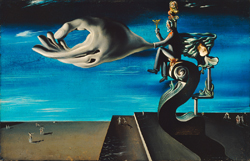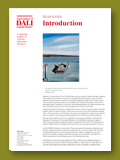
Salvador DALÍ
Spanish 1904–89, worked in United States 1940–48
Archeological reminiscence of Millet's Angelus (c. 1934)
oil on wood panel
31.8 x 39.4 cm
The Salvador Dalí Museum, St Petersburg, Florida
Worldwide Rights: © Salvador Dalí, Fundació
Gala-Salvador Dalí, VISCOPY, 2009.
In the USA: © Salvador Dalí Museum Inc.,
St. Petersburg, FL, 2009

Salvador DALÍ
Spanish 1904–89, worked in United States 1940–48
The hand. The remorse of conscience 1930
oil and collage on canvas
41.0 x 66.0 cm
The Salvador Dalí Museum, St Petersburg, Florida
Worldwide Rights: © Salvador Dalí, Fundació
Gala-Salvador Dalí, VISCOPY, 2009.
In the USA: © Salvador Dalí Museum Inc.,
St. Petersburg, FL, 2009

Salvador DALÍ
Spanish 1904–89, worked in United States 1940–48
Memory of the child-woman 1932
oil on canvas
99.1 x 120.0 cm
The Salvador Dalí Museum, St Petersburg, Florida
Worldwide Rights: © Salvador Dalí, Fundació
Gala-Salvador Dalí, VISCOPY, 2009.
In the USA: © Salvador Dalí Museum Inc.,
St. Petersburg, FL, 2009
LEFT: Salvador DALÍ
Spanish 1904–89, worked in United States 1940–48
Slave market with apparition of the invisible
bust of Voltaire 1940
oil on canvas
46.4 x 55.2 cm
The Salvador Dalí Museum, St Petersburg, Florida
Worldwide Rights: © Salvador Dalí, Fundació
Gala-Salvador Dalí, VISCOPY, 2009.
In the USA: © Salvador Dalí Museum Inc.,
St. Petersburg, FL, 2009
Following André Breton's invitation to join the Surrealist movement in 1929, Dalí quickly established himself as the leading Surrealist artist. He spent a great deal of time in Paris over the ensuing decade, where he established friendships with wealthy Parisian patrons and artists. The beginning of Dalí's Surrealist period marked a growing confidence in his own style. The establishment of the representation of 'hard' and 'soft', which formed the foundation of his aesthetic, and the creation of motifs and symbols which became part of his artistic vocabulary throughout his oeuvre, were consolidated at this time. Ants, crutches, keys, watches, lobsters, bread, eggs and other Dalinian clues were all painted to be interpretable through the lens of Freudian psychology. Dalí's most striking works combined this dream imagery with echoes of the majestic plains of the Empordà, or the fantastical rock formations found at Cap de Creus, near Cadaqués.


